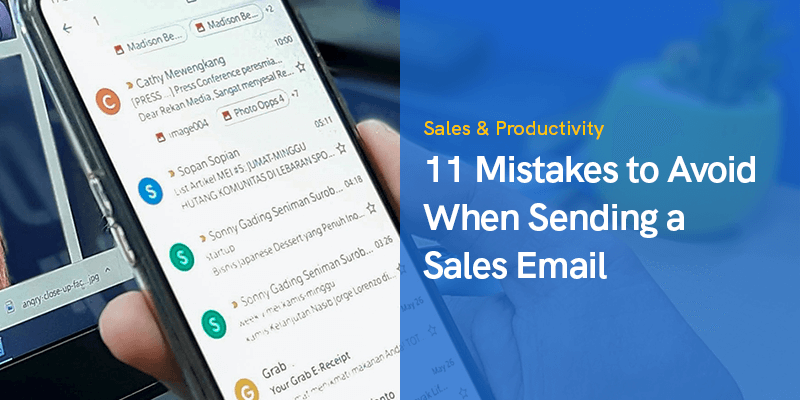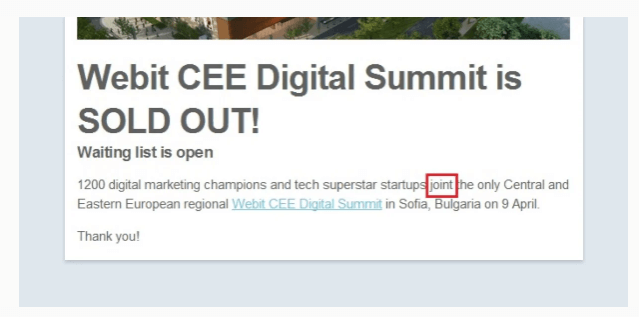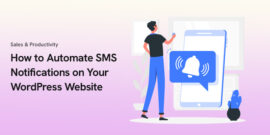
11 Mistakes to Avoid When Sending a Sales Email
When you’re writing a sales email, there are a number of basic mistakes that can kill your credibility.
First impressions are crucial.
If potential clients see something they don’t like, you can forget about closing that sale.
However, some of these mistakes are easier to spot and avoid than others.
I’ve compiled a list of the eleven sales email mistakes I see most often.
Check out our article on the best email marketing platforms: 20+ Best Email Marketing Services .
Mistakes to Avoid When Sending a Sales Email
This list will help you notice these mistakes, weed them out, and create the perfect email that will help you generate more sales.
Let’s get started!
Using a Weak Subject Line
If your subject line is weak, your prospect won’t even open your sales email.
The subject line is the first thing they see.
if it doesn’t pique their interest, they’ll delete your email and forget about you.
Your subject line should be short, descriptive, and enticing.
According to Marketingdive, personalizing your subject line can also increase open rates by a whopping 50%.
Therefore, consider using the prospect’s name or other relevant detail – such as company name, job role, or a reference to where you met them – in your subject line.
Here are some other top tips for writing great subject lines:
- Use emojis.
- One study showed that emojis in the subject line increased the open rate by up to 50%.
- Ask a question (e.g., How happy are you with your current [product/service]?)
- Write as you would to a friend.
Don’t be afraid to try out different subject lines and monitor your results.
By running A/B tests, you can easily assess which ones are the most effective.
Misspelling Words
Misspelled words are the most common error found in emails, according to Grammarly.
How many times have you switched the i and the e in “receive”? How about replacing the a with an i in words ending in “-able”?
Here are some commonly misspelled words you may find yourself using a sales email (correct spellings in parentheses):
- Accomodate (accommodate)
- Acheive (achieve)
- Seperate (separate)
- Succesfull (successful)
- Tomorow or tommorow (tomorrow)
- Untill (until)
These are just a few of the many examples.
We all have our “nemesis words” – those we can never spell correctly the first time. Learn yours.
People also commonly misspell proper nouns such as people’s names and place names.
The next time you write a sales letter, make sure you check the spelling.
It sounds simple, but it really does make a difference.
If a prospective customer receives an email littered with spelling errors, their impression of your professionalism will be tarnished.
And if you refer to someone as “John” instead of “Jon,” you can probably say goodbye to your sale.
Grammatical Errors
Grammatical errors can also damage your reputation and decrease your chances of landing a sale.
Poor grammar is indicative of sloppy, careless work, which looks deeply unprofessional.
Impeccable grammar is crucial to conversions in email marketing. However, email marketing tools like WordPress email marketing plugins or other software can have an impact as well.
Here’s an example of an email with an easily avoidable grammatical error:

Image source: MailerLite
Therefore, proofread your letter thoroughly before you send it.
If you have a colleague who is great with grammar, ask them to check it over, too.
If you’re unsure about a sentence, Google it.
Repeating Words
When writing a sales letter, you might type the same word twice, especially when you’re in a hurry.
Unfortunately, because of how the human brain works, this is one of the hardest errors to catch.
As you read a phrase, your brain processes it as a whole.
Therefore, if there is an instance of word repetition that you were not expecting, it becomes incredibly easy to miss.
Image source: BrainHQ
To avoid this mistake, proofread your sales letter several times.
Reading it aloud can also help you spot repetition you might have missed.
You can avoid those first three issues by using a grammar checker.
Mistyping Your Contact Information
Providing the correct contact information is important.
If you mistype your phone number (or other pertinent contact information) in your sales email, your prospect might not be able to get in touch with you! And if they can’t contact you easily, they just won’t bother.
This is an even bigger problem when you’re sending a mass email.
If you take the time to build a sales email list but then mistype your contact information in a communication with your list, there’s no telling how many sales you might lose as a result.
The key to avoiding this error? Proofreading and double-checking.
Don’t rely on your memory.
Instead, copy your information directly from your business card or company website.
Getting the Date Wrong
Imagine this scenario: you send an email to a prospect, and agree to set up a meeting on September 15.
However, when the date comes, you don’t show up and your prospect is left waiting.
You only realize your mistake when you turn up on September 16.
You’ve probably faced this problem at least once.
When setting up a meeting or call, confirm the date.
It’s a surprisingly easy error and it can cost you business.
Sharing an Incorrect Link
As part of your email prospecting, you may wish to send prospective customers a link to a particular product page, piece of content, or other relevant webpages.
Later, you discover that one or more of your links was broken or led to the wrong page.
If you make this mistake, most recipients won’t bother to look up the correct information.
Most likely, they’ll simply delete your email and move on.
To avoid this issue, test your links before you press send.
Ideally, send a test version of the email to a colleague and ask them to check the links work, too.
Being Vague
Not just sales emails, but any piece of content must have a clear call to action (CTA).
A Good CTA instantly shows the impact of well-written content.
Your email copy should be direct with one clear, specific call to action CTA.
Here are some crucial characteristics of a great CTA:
- Use strong, action-oriented verbs.
- Create a sense of urgency.
- Repeat the CTA in your copy.
Your CTA is what makes a prospect hit reply or visit a page.
If it is not clear, specific, and easily actionable, most people will simply fail to react to your sales email.
Sending Sales Emails to Unverified Email Addresses
Every time one of your sales emails bounces, it will have a negative impact on your deliverability score.
A low deliverability score means more of your emails will end up in prospects’ spam folders, where they’ll languish unread until they are automatically deleted.
Fortunately, there’s a simple solution to this problem: verify all email addresses before you send any emails.
A tool like Voila Norbert can bulk-verify email addresses, allowing you to remove any that are incorrect or invalid.
Define Your Value Proposition
If you want your prospects to respond to your sales email and take action, you need to give them a compelling reason.
In other words, what’s in it for them?
Ensure your sales emails focus on the value you can provide.
Your prospect is unlikely to care if you think your product is the best thing ever.
They care if it will address a pain point, solve a problem, or make their life easier in some way.
Be clear and specific as you explain the benefit of your offering.
When you discuss your product, solution, or service, do not simply talk about features.
Instead, identify the ways it will help your prospective customer.
Pro tip: mass sales emails are out.
Segmenting your audience means you can offer relevant, value-focused sales pitches to each group of potential customers.
Segmentation takes a little longer, but the results are more sales.
Keep it Short & Concise
One of the biggest mistakes that I see new salespeople making is trying to cram too much information into a sales email.
Keep your email short and sweet.
A successful sales email should have the following four elements:
- An attention-grabbing headline, making the prospect want to read on.
- A short introduction, detailing who you are and why you’re writing.
- Three to four paragraphs describing the benefits of the product or service.
- A call to action, telling your prospect what you’d like them to do next.
- (Buy now? Book a sales call?)
Your prospective customers are busy people and do not have time to absorb lots of irrelevant information.
Get to the point.
Bottom Line
Great sales emails are crucial to landing the sales you want.
Your sales email might be the first time a prospect has interacted with you, so you need to make a great first impression.
If you commit any of these mistakes, you’re likely to be losing out on potential sales.
Take your time to perfect your sales emails.
Proofread them, ask for help from colleagues, and use a spelling and grammar checker to catch any errors you’ve missed.
Remember that the devil is in the details.
By taking a few extra minutes to write amazing sales emails and check them over for these common mistakes, you’ll increase your success and increase conversions.
The outcome is clear: error-free emails bring you a step closer to achieving your goals!
Recommended Posts

The Ultimate Guide to Effortlessly Automate SMS Notifications on Your WordPress Website in 2025
April 4, 2025

AcyMailing & MEC: A Seamless Integration Guide for 2025
January 28, 2025

Top 5 Email Marketing Tools for Event Promotion in 2025
January 21, 2025

